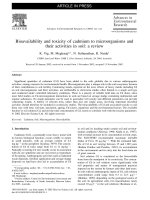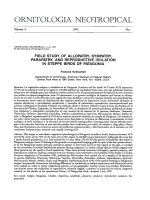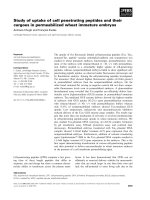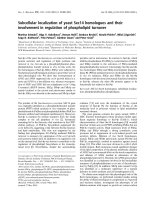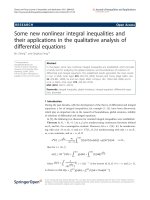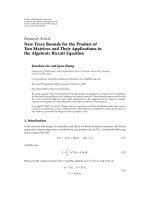Theoretical study of carbon based materials and their applications in nanoelectronics
Bạn đang xem bản rút gọn của tài liệu. Xem và tải ngay bản đầy đủ của tài liệu tại đây (5.07 MB, 167 trang )
THEORETICAL STUDY OF CARBON-BASED MATERIALS
AND THEIR APPLICATIONS IN NANOELECTRONICS
KAI-TAK LAM
NATIONAL UNIVERSITY OF SINGAPORE
2011
THEORETICAL STUDY OF CARBON-BASED MATERIALS
AND THEIR APPLICATIONS IN NANOELECTRONICS
KAI-TAK LAM
A THESIS SUBMITTED
FOR THE DEGREE OF DOCTOR OF PHILIOSOPHY
DEPARTMENT OF ELECTRICAL AND COMPUTER ENGINEERING
NATIONAL UNIVERSITY OF SINGAPORE
2011
i
Acknowledgements
I would like to take this opportunity to thank my Ph.D. supervisor, Assistant
Professor Liang Gengchiau for his guidance and support throughout my graduate
study at NUS. I am immensely indebt to his willingness to share his knowledge and I
greatly appreciate the intellectual freedom given in pursuing my research interests.
Without his careful supervision, constructive feedback and constant encouragement,
much of the works in this thesis would not have been possible.
I am also grateful to Associate Professor Ganesh S. Samudra and Assistant
Professor Yeo Yee Chia for their advices and insightful discussions during my course
of study. In addition, I would like to express my gratitude toward Dr. Chin Sai Kong
from the Institute of High Performance Computing for his help and guidance during
our collaborations.
Next, I would like to thank my fellow course mates and colleagues for their
assistance and friendship during my Ph.D. candidature. They have made my graduate
studies an enjoyable and memorable experience in my life. In particular, thanks go
out to Dr. S. Bala Kumar, Dr. Da Haixia, Huang Wen, Qian You and many others for
their valuable inputs and discussions. I would also like to thank the Outreach group
of the Department of Electrical and Computer Engineering for the opportunities in
promoting science and engineering to the secondary and pre-university students and
for the exposure to the works of fellow researchers in NUS.
Lastly, I would like to extend my heartfelt appreciation to my parents for their
unwavering faith in me and to my sister, Jessica Lam Ching Yee for her constant
encouragement. Without their understanding and support, my graduate career would
not have been possible.
ii
Table of content
Acknowledgements i
Table of content ii
Abstract vii
List of Figures ix
List of Symbols xix
Chapter 1 Introduction 1
1.1 Why carbon? 3
1.2 Objectives of research 6
1.3 Thesis organisation 6
1.4 References 8
Chapter 2 Methodology 11
2.1 Density functional theory 11
2.2 p
z
-orbital tight binding method 13
2.3 Dirac tight binding method 17
2.4 Non-equilibrium Green’s function formalism 19
2.4.1 Ballistic limits 19
2.4.2 Phonon scattering 21
2.5 Summary 24
2.6 References 25
Chapter 3 Material properties of graphene-based materials 27
3.1 Electronic structure of monolayer graphene nanoribbon 27
iii
3.1.1 Armchair edges 27
3.1.2 Zigzag edges 29
3.1.3 Dopant effect 30
3.2 Electronic structure of bilayer graphene nanoribbon 31
3.2.1 Armchair edges 32
3.2.2 Zigzag edges with dopants 33
3.2.3 Effect of changing interlayer distance on energy band gap 34
3.3 Stability and electronic structure of two dimensional C
x
(BN)
y
compound 35
3.3.1 Introduction 35
3.3.2 Simulation model 37
3.3.3 Results and discussions 39
3.4 Summary 42
3.5 References 44
Chapter 4 Schottky barrier field-effect transistors 47
4.1 Introduction 47
4.2 Simulation setup 49
4.3 Results and discussions 50
4.3.1 AGNR SBFETs 50
4.3.2 ZGNR SBFETs 51
4.3.3 Device performance comparison 52
4.3.4 Bilayer devices 53
iv
4.4 Summary 54
4.5 References 55
Chapter 5 Bilayer graphene nanoribbon nanoelectromechanical system 57
5.1 Introduction 57
5.2 Operating principle 60
5.3 Parallel plate actuator floating gate design 63
5.4 Design evaluation 64
5.4.1 Capacitive parallel plate actuator 65
5.4.2 Electrostatic repulsive force actuator 68
5.5 Summary 73
5.6 References 74
Chapter 6 Resonant tunnelling diode 78
6.1 Shape effects in graphene nanoribbon resonant tunneling diodes 79
6.1.1. Introduction 79
6.1.2. Simulation approaches 82
6.1.2. Results and discussion 83
6.2 Influence of edge roughness on graphene nanoribbon resonant
tunnelling diodes 91
6.2.1. Introduction 91
6.2.2. Simulation approaches 93
6.2.3. Results and discussions 94
6.3 Summary 100
v
6.4 References 102
Chapter 7 Tunnelling field-effect transistor 106
7.1 Tunneling FET with heterojunction channel 106
7.1.1. Introduction 106
7.1.2. Simulation approachs 108
7.1.3. Results and discussions 109
7.2 Electrostatics of ultimately-thin body tunneling FET 113
7.2.1. Introduction 113
7.2.2. Simulation approaches 115
7.2.3. Results and discussions 115
7.3 Device performance of GNR MOSFET and tunneling FET with phonon
scattering 120
7.3.1. Introduction 120
7.3.2. Simulation approaches 121
7.3.3. Results and discussions 122
7.4 Summary 126
7.5 References 127
Chapter 8 Suggestions for future work 132
8.1 Bilayer graphene nanoribbon 132
8.2 GNR Schottky barrier field-effect transistors 133
8.3 High frequency applications 135
8.4 References 136
vi
Appendix I
Appendix A: Derivation of Dirac equation for 2D graphene I
Appendix B: Dirac Hamiltonian for GNR III
Appendix C: List of publications IV
vii
Abstract
Continual scaling down of silicon device, which is the main driving force in
device performance enhancement, is not sustainable as we approach the physical
limits of silicon and it is foreseen that new materials and novel device structures will
be required for future device improvements. In this regards, research in carbon
electronics has been intensified since 2004 due to the physical realization of
thermodynamically stable planar graphene. Two-dimensional monolayer graphene
sheets have unique electrical and physical properties which can be exploited in new
device structures. However, due to its semi-metallic nature, much focus has been
given to converting graphene based materials into semi-conducting material, such as
applying a perpendicular electric field to a bilayer graphene and impurity adsorption
on the graphene surface. A more commonly studied method involves cutting two-
dimensional graphene sheets into one-dimensional narrow ribbons, i.e. graphene
nanoribbons (GNRs), where the quantum confinement introduced by the physical
edges generate an energy bandgap that is closely related to the width and edge
configurations of the ribbon. Such semi-conducting GNRs can be relatively easy to
integrate into existing device structures and the unique electronic properties can be
used in new device applications.
Both experimental and theoretical studies have been carried out extensively on
integrating GNRs into existing device technologies such as metal-oxide-
semiconductor field-effect transistors. In addition, bilayer GNRs, which combine the
unique electrical properties of GNRs and bilayer graphene, show great potential as
versatile materials which can enable new device designs that take advantage of
tuneable energy bandgap such as nanoelectromechanical devices. Recent development
viii
in obtaining GNRs by unzipping carbon nanotubes has made the prospect of
fabricating GNR-based electronic devices in large quantities more promising and
hence, detailed understanding of the device physics of GNR-based devices are much
needed.
This thesis, therefore, summarizes the investigation of the electronic structures
of GNRs, both monolayer and bilayer, and materials with graphene-like atomic
structure such as boron-nitride-carbon (B-N-C) compound. In addition, potential
devices that can be implemented with these materials are also studied in details. Using
various methods for the calculation of the electronic structure of the material, such as
density functional theory, π-orbital tight-binding model and the Dirac equation model
and utilizing the general non-equilibrium Green’s function approach to simulate the
electron transport for device evaluations, with the inclusion of acoustic and optical
phonon scattering, the performance of various devices such as Schottky Barrier field-
effect transistors (FET), nanoelectromechanical switches, resonant tunnelling dioides
and the effects of heterojunction, fringing field, and phonon scattering on tunneling
FET based on GNRs are evaluated. This exploration on the device physics and
performance of carbon electronics serves to enhance the knowledge for post-silicon
device investigations.
ix
List of Figures
Fig. 1-1 (a) Face-centered cubic lattice of sp
3
hybridized carbon. (b) Hexagonal
lattice of sp
2
hybridized carbon, showing the eigenstates near the Dirac
point. These states corresponds to the π and π* bonds form by the
adjacent p
z
orbital. (c) Electron dispersion of graphene, with the unique
linear dispersion at the Dirac point shown in inset. 4
Fig. 1-2 (a) Current characteristic of graphene field-effect device from [5]. (b)
Frequency response of a graphene field-effect transistor from [12] 4
Fig. 1-3 (a) Electronic structure of bilayer graphene with and without a
perpendicularly applied bias, represented by the solid and dashed lines,
respectively. (b) The induced energy band gap, Δ
g
, as a function of the
applied bias (top axis) and electron density (bottom axis). The applied
bias acts as an electrostatic doping in addition to inducing the energy band
gap. Figures taken from [10] 5
Fig. 2-1 Electronic structure of (a) two dimension graphene and (b) an armchair-
edged graphenen nanoribbon as calculated from ATK. The Dirac point at
K is one of the distinct features of graphene 13
Fig. 2-2 An atomic schematic of a N
A
= 5 AGNR (width = 0.49 nm) is shown in
(a). The dashed box denote the unit cell for π-orbital tight binding
calculation and the numbering of the atoms corresponds to the manner the
Hamiltonian is extracted. The electronic structure as calculated with edge
modification to the Hamiltonian is shown in (b) and a close up at the
boxed region near the Fermi level is shown in (c). The solid lines denote
the calculation with edge modification and the dashed lines do not have.
For both (b) and (c) the positive values (blue lines) represent the
conduction bands and the negative values (red lines) represent the valence
bands. 16
Fig. 2-3 Electronic band structures of armchair graphene nanoribbons as calculated
by our Dirac tight binding approach is similar to that from the more
accurate p
z
-orbital tight binding method 19
Fig. 2-4 A schematic summarizing the models and methods used in this thesis as
detailed in Chapter 2. 24
x
Fig. 3-1 Atomic structure of intrinsic (a) AGNR and (b) ZGNR and their edge-
doped counterparts are shown in (c) and (d), respectively. Nitrogen atoms
are used for doping and are represented by the blue atoms. The electronic
structure as calculated by DFT method is shown in (e) for AGNR with
widths of 0.98, 1.11 and 1.23 nm and in (f) for ZGNR with widths of 0.92,
1.14 and 1.35 nm. The effect of atomic doping on 0.98nm AGNR is
shown in (g) and a similar plot for 0.92nm ZGNR is shown in (h). The
dash boxes in (a) to (d) denote the unit cell used for the calculation of
band structures (e) to (h) respectively. Due to the superlattice structure
used, zone folding is observed in (g) and (h) 28
Fig. 3-2 Variation in energy band gap with respect to the ribbon widths for (a)
intrinsic AGNR and (b) nitrogen-doped ZGNR. The inset in (b) shows
the energy band gap variation and the shift in Fermi level as the doping
concentration changes 29
Fig. 3-3 (a) and (b) shows the top and side view of the Bernal stacking of bilayer
graphene nanoribbon considered in this work. Atomic structures of semi-
conducting bilayer graphene nanoribbons are shown for (c) intrinsic
AGNR
B
and (d) nitrogen-doped ZGNR
B
and their corresponding
electronic structures shown in (e)-(h). A comparison between the
monolayer (solid lines) and bilayer (dashed lines) GNRs are made in (e)
and (f) where it is observed that the energy band gap reduced in general
for bilayer GNRs. The effect of increasing the interlayer distance on
electronic structures on bilayer GNRs are shown in (g) and (h) which
show that as the interlayer distance is increased from 3.2 (solid lines) to
5.0 Å (dash lines), the energy band gap is increased. 32
Fig. 3-4 The variation in energy band gap for AGNR and AGNR
B
as the width
changed. In general the energy band gap for bilayer structure is smaller
than that of the monolayer counterpart, with the 3p+2 family (triangle
markers) becoming metallic. For larger widths, the 3p (diamond markers)
and 3p+1 families (circle markers) becomes very close to each other. The
energy band gap variation for optimum and large interlayer distance (D)
in AGNR
B
is also show here with solid and empty markers, respectively.
33
Fig. 3-5 Variation in energy bandgap of semiconducting bilayer graphene
nanoribbons as a function of the interlayer distance for (a) intrinsic
AGNR
B
with widths 0.98, 1.11 and 1.23 nm and (b) nitrogen-doped
ZGNR
B
with width 0.99 nm 35
xi
Fig. 3-6 The atomic model for BC
2
N forming (a) phase-segregated and (b) evenly
distributed zigzag chains. The phase-segregated armchair chain
configuration is shown in (c). The empty solid and the solid dot are boron
and nitrogen atoms respectively, with the black lines representing the
original graphene arrangement. The repeating unit cell is indicated by the
box in the respective figures. (d) The Brillouin zone for the usual
hexagonal lattice (dash line) and the studied rectangular lattice (solid) and
the respective high-symmetry points. The electronic structure is
calculated along Y-Γ-X 37
Fig. 3-7 (a) The phase’s progression from evenly distributed (A) to total
segregation (E). Adjacent BN and carbon dimers are swapped in each
different phase, denoted by the dash boxes. (b) The swapping of BN and
carbon dimers are visualised where there exist two different paths of
progress. (c) The E
form
for the different phases of BC
2
N as shown in (a).
The E
form
between phases are where the swapping of BN and carbon
dimers occurs, which can have two different paths (cross and diamond).
(d) Total energy variation plot from the nudged elastic band method for
obtaining the activation energy required for phase-segregation to occur.
The initial and final state (top insets) correspond to the top two diagrams
in (b). Activation energy of 13 eV is required for this 8-atom superlattice,
which translates to 1.63 eV/atom, to undergo the initial step of phase-
segregation. Here, blue, pink and gray atoms represent nitrogen, boron
and carbon respectively 39
Fig. 3-8 The electron dispersion of (a) partially segregated and (b) evenly
distributed BC
2
N forming zigzag chains, with the eigenstate plots for the
conduction and valence bands shown at the left and right of the figures
respectively. The energy gap (E
G
) as a function of different concentration
of C for partially segregated and evenly distributed configurations with
both zigzag (ZZ) and armchair (A) chains are shown in (c) and (d),
respectively. 41
Fig. 4-1 Atomic representations of (a) AGNR and (b) ZGNR SBFET. (c) The
current characteristics of AGNR SBFET with different channel lengths
(L
C
) with an inset showing the positive and negative gate bias responses
for L
C
= 8.8 nm. The transmission plots, with the inset showing a zoom-in
of the low transmission region is shown in (d). The energy scale here is
normalized with the Fermi level (E
F
) of the devices, i.e. E
F
= 0. The peaks
near E
F
for all L
C
are contribution from the metal-induced gap states near
the source and drain contacts. 49
Fig. 4-2 (a) The I-V
G
of AGNR SBFET with different channel widths (W
C
). The
current is normalized with the respective channel widths. The
corresponding transmission plots are shown in (b), with the energy scale
normalized to the respective E
F
. 50
xii
Fig. 4-3 (a) Total energy of the ZGNR with nitrogen dopant at different position,
normalized with respect to the lowest energy. The inset shows the atomic
arrange of the nitrogen-doped ZGNR. (b) The electron dispersions of the
intrinsic and N-doped ZGNR. The energy scales of the two plots have the
same vacuum level and the dash lines represent the respective E
F
. (c) The
change in the E
G
with respect to the W
C
. (d) The current characteristics of
nitrogen-doped ZGNR SBFETs with different W
C
. Inset shows the
variation in the I
OFF
bias (V
OFF
) as the W
C
increases. The corresponding
transmission plots are shown in (e) where the effect of decreasing E
G
can
be observed. 52
Fig. 4-4 (a) The subthreshold swing (SS) of the AGNR and ZGNR SBFETs as a
function of the respective W
C
. (b) The ON-state/OFF-state current ratios
(I
ON
/I
OFF
) and (c) the respective I
ON
and I
OFF
as a function of W
C
. 53
Fig. 4-5 The I-V plots of bilayer (a) AGNR SBFET and (b) ZGNR SBFET. The
monolayer counterparts are plotted as dashed lines for comparison. The
transmission plots of the bilayer (c) AGNR and (d) ZGNR devices show
the effect on the transmission for smaller E
G
materials 54
Fig. 5-1 A schematic of the bilayer graphene nanoribbon (BGNR) device
implemented as (a) a force sensor and (b) a nanoelectromechanical switch.
An atomic representation of the BGNR nanoelectromechanical device is
shown in (c). The edges of the bilayer are passivated with hydrogen
(white) atoms. The source (S) and drain (D) of the device are zig-zag
edged BGNR while the channel is armchair edged BGNR and is bent at
30° with respect to the contacts. (d) The side view of the device is shown
where the covalent radii of the atoms are represented 59
Fig. 5-2 (a) The energy bandgap (E
G
) dependency on the interlayer distance (D)
with the dash line representing the E
G
of the monolayer counterpart. The
operating principle of the device is summarized in (b). At the given
electrostatic doping (e.g. 0.25 eV), as D decreases, the E
G
decreases and
the conduction band (E
C
, solid line) moves closer to the Fermi energy (E
F
,
dot-dash line). As the E
C
crosses E
F
, the device is completely turned on
and a large current is obtained. (c) The current-voltage characteristics of
the device at different electrostatic doping conditions (E
F
-E
i
). The device
is in ON-state when D is small, and in OFF-state at large D 60
xiii
Fig. 5-3 (a) The pressure (upward positive) perpendicular to the plane of the
device and the total energy (normalized to the minimum value) are plotted
against D. The minimum pressure required to switch the device is 5.51
nN/nm
2
. Schematic of the BGNR NEMS switch at (b) initiate state and
when (c) a gate bias is applied. The dashed lines represent the BGNR and
the mobile electrode is attached to an oxide layer grown above the BGNR.
(d) A simple model used for the analysis of the parallel plate actuator
floating gate. (e) The current characteristics of the NEMS switch as the
V
G
varies. The solid line shows the current changes as the forward V
G
is
applied and the dashed line shows the V
G
in reverse. The circle indicates
the threshold gate bias (V
TH
) where the device switches from ON-state to
OFF-state 62
Fig. 5-4 (a) An addition layer of oxide is placed between the fixed and mobile
electrodes to modulate the device behavior. (b) The total capacitance
across the electrodes. The current characteristics of the floating gate
design with (red, thick lines) and without (black, thin lines) the added
oxide layer for channel length of (c) 10.1 and (d) 14.9 nm. The solid and
dash lines indicate increasing and decreasing V
G
, respectively and the
region enclosed by them is the hysteresis loop. The spring constant κ = 1
N/mm for all cases. 67
Fig. 5-5 (a) The relationship between the change in gap thickness (Δt
gap
/t
gap
) and
the ratio, p = F
E
/ (F
S
+ F
GNR
) for original (black, thin line) and for
modified (red, thick line) CPP designs. The dash thick line is for the case
F
GNR
= 0, which indicates that the F
GNR
disrupt the linearity of the device
which results in the hysteresis loop. The device characteristics are shown
for (b) different spring constants κ (in N/mm) and (c) different oxide
thickness t
ox
(in nm). The oxide dielectric constant is set at 4 67
Fig. 5-6 Optimization plot for V
TH
and the hysteresis loop (dV) with respect to the
spring constant κ and the oxide capacitance C
ox
. The unit of the colorbars
representing the respective plots is V. 68
Fig. 5-7 (a) 3D view of the device structure. The BGNR is placed in the air gap in
between the oxide layers. By applying a voltage of +V
E
to the peripheral
electrodes and a voltage of –V
E
to the aligned electrodes, the top mobile
electrode is repelled from the bottom fixed electrode and it moves along
the +Z direction. (b) Top view of the device showing the peripheral
electrodes and the inter electrode distance (IED). (c) Side view of the
device showing the aligned electrodes, the oxide thickness (t
ox
= 1 nm)
and the distance of separation, D between the two GNR layers. (d) Zoom
in of the side view showing the BGNR layer. (e) V
E
> V
TH
. Switch in
OFF-state showing the balancing of the forces 70
xiv
Fig. 5-8 Plot of the electric field with the arrows showing the direction and relative
magnitude of displacement of the top movable electrode. The color bar
represents the electric field in V/nm. 70
Fig. 5-9 I-V curves showing: (a) the effect of varying IED. Reduction in IED
causes increase in C and hence the V
TH
is reduced; (b) the effect of
increasing the dielectric constant, ε of the ambient using liquid packaging
(IED = 1 nm). A larger ε increases C and hence lowers the V
TH
. 72
Fig. 6-1 Schematics of the simulated armchair-edged graphene nanoribbon
resonant tunneling diodes (AGNR RTDs) with different shapes, namely (a)
H, (b) W, and (c) S-shape. Energy band diagram for these differently
shaped AGNR RTDs at equilibrium is shown in (d), illustrating the double
barrier quantum well structure for RTD operation. 80
Fig. 6-2 (a) Current-Voltage characteristics of the H (solid line), W (dashed line),
and S-shape (dash-dot line) AGNR RTDs at 40 K. All of them show the
negative differential resistance, with the peak currents positions occurring
at the same applied bias. This indicates that the transmission peak
positions of these different shape cases are robust and independent of the
shapes. (b) Calculated transmission Tr(E) (color bar represents the
transmission) through the H-shape AGNR RTD at different biases. Its
transmission peaks shift under the applied bias and the current increases
as the peaks approach and cross the Fermi energy (E
F
). As the peaks
disappear when they reach the conduction band edge (E
C
), the current also
decreases and hence the NDR characteristic. The cross points in (b)
correspond with the bias points of the solid line in (a). Current spectrums
of the selected bias points: (c) 0.04, (d) 0.06, and (e) 0.12 V, shown as
circle points in (a) and (b) 82
Fig. 6-3 (a) Transmissions of the various RTDs are shown in semi log scale. The
first peak corresponds to the tunneling of carriers to the first energy state
within the DBQW and is responsible for the peak currents. The inset
shows that the transmission peak is highest for the W-shape device and
hence the largest current in the I-V plot at 290 K shown in (b) 84
Fig. 6-4 The current flux plot for (a) H, (b) W, and (c) S-shape AGNR RTDs at E
= E
peak
of the I
peak
under the corresponding bias. W-shape device has an
uninterrupted bottom edge which allows for a continuous flow of carrier,
while H-shape device shows great disruption at the abrupt interfaces at
both the top and bottom edges. 86
xv
Fig. 6-5 (a) The Peak-Valley Ratio (PVR) of H (solid line), W (dash line) and S
(dash-dot line) at different temperatures. (b) The peak currents (I
peak
)
decreases with temperature while (c) the valley currents (I
valley
) increases.
This leads to the exponential decrease of PVR with increasing temperature.
86
Fig. 6-6 Current spectrums of (a) I
peak
and (b) I
valley
are shown at different
temperature for W-shape device, shifted in the x-axis by the amount
shown above the arrows for clarity. The area covered by the current
spectrum gives the current and this area for I
peak
decreases, while the area
for I
valley
increases as temperature increases. The dotted horizontal lines in
both figures represent the barrier height of the left barrier estimated using
equilibrium band diagram, cf., Fig. 6-1(d) 88
Fig. 6-7 (a) The current characteristics of GNR RTD with different channel width:
2.1 (dash), 2.8 (dotted) and 3.6 nm (solid) for the H-(black), S-(blue) and
W-(red) shape devices. (b) The corresponding transmission spectrum for
W-shape device is shown for different channel width. (c) The bias at
which the peak current occurs (V
peak
) is plotted against the channel width.
The (d) PVR, (e) I
peak
and (f) I
valley
of the devices as a function of channel
width are also shown to compare the device performance. 90
Fig. 6-8 (a) The current characteristics of GNR RTD with different channel lengths:
4.0 (dash), 7.0 (solid) and 10.0 nm (dotted) for the H-(black), S-(blue) and
W-(red) shape devices. (b) The corresponding transmission spectrum for
W-shape device is shown for different channel lengths. (c) The bias at
which the V
peak
is plotted against the channel lengths. The (d) PVR, (e)
I
peak
and (f) I
valley
of the devices as a function of channel lengths are also
shown to compare the device performance 91
Fig. 6-9 Atomic schematics of (a) H-, (b) S- and (c) W-shaped graphene
nanoribbon resonant tunnelling diode (GNR RTD) with 15% edge
roughness. The solid line shows the smooth edged devices. The length and
width of the GNR forming the barrier region are 5.1 and 1.4 nm
respectively, with an energy gap of 0.67 eV. The quantum well (active)
region is 7.0 nm long and 3.6 nm wide, with an energy gap of 0.28 eV.
The semi-infinite contact is of width 2.8 nm with an energy gap of 0.43
eV 93
Fig. 6-10 Energy band gap of an AGNR super cell as a function of GNR width for
different edge roughness. The length of the super cell is 21.5 nm. The
inset shows the relation between energy gap of 1.4 and 3.6 nm width GNR
super cell and the edge roughness percentage. 94
xvi
Fig. 6-11 The local density of states (LDOS) plot along the length of the device for
GNR RTD with (a) 0%, (b) 5%, (c) 10% and (d) 15% edge roughness.
The white solid line represents the schematic band-diagram of GNR RTDs
with consideration of edge roughness [32] and the white dashed line
represents the Fermi level position (E
F
= 0.24 eV) used in this study.
Compared to the smooth case, the first quantum state is found to be lower
and its broadening increases because the effective barrier height becomes
lower and effective barrier width becomes thinner 95
Fig. 6-12 The current characteristics of the different shaped GNR RTDs with (a) 0%,
(b) 5%, (c) 10% and (d) 15% edge roughness. The corresponding
transmission plots are shown in (e)-(h). Due to the fact that the first
quantum state lowers down, V
peak
moves down except for the case of 15%
edge roughness because its V
peak
is contributed by the second quantum
state instead of the first one. Furthermore, unlike the smooth case, V
peak
positions of the different shape devices with the same edge roughness
positions split. It can be attributed to different scattering effects caused by
edge roughness in the different shapes. 97
Fig. 6-13 The average device performance of 60 GNR RTD samples with different
shapes in terms of (a) V
peak,avg
, (b) I
peak,avg
, (c) I
valley,avg
and (d) average
peak-to-valley current ratio are shown as a function of the edge roughness.
The increase in edge roughness percentage leads to a larger increase in
I
valley,avg
the I
peak,avg
which results in a drop of 25% in average peak-to-
valley current ratio for 15% edge roughness as compared to the smooth
case 100
Fig. 7-1 (a) Cross-section schematic of a simulated GNR TFET and (b) atomic
model of a TFET with uniform GNR width (plan view). Three different
structures are proposed and the respective plan-view atomic models are
shown in (c) - (e). The dark gray zones represent the source and drain
regions 107
Fig. 7-2 The current-voltage characteristics of GNR TFETs with different atomic
configurations. The applied drain bias (V
DS
) is 0.6 V and the flat band bias
V
fb
is 0.3 V. The I
ON
in linear scale corresponding to the dashed box in (a)
is shown in the upper left inset while the I
ON
versus I
ON
/I
OFF
in log scale in
shown in the lower right inset 111
Fig. 7-3 The local current density [J(E) in A/eV] for the different GNR TFET
structures at OFF-state [(a)-(c)] and ON-state [(d)-(f)]. The level of
current is proportional to the electron tunneling shown by the gray bands
shaded to scale. 111
xvii
Fig. 7-4 The I
ON
and I
OFF
of HJ02 GNR TFET as function of the channel length are
shown in (a). The local density of states plots for L
C
= 16 and 10 nm at
V
GS
- V
fb
= 0.6 V corresponding to the dash-box area in Fig. 7-3(f) is
shown in (b). The arrows show the quantized states between the source
and the narrow region in the channel. The chemical potential of the source
is set at 0 eV 112
Fig. 7-5 (a) 3D representation of the double-gated (G) GNR TFETs. (b) A cross
sectional view along the dash line in (a), with a p-doped source, an n-
doped drain, and an intrinsic channel. The current characteristics of GNR
TFETs with different oxide thickness (t
ox
) and different dielectric
constants (ε
ox
= ε
ox_C
= ε
ox_G
) are shown in (c) and (d), respectively, with
the devices biased (V
DS
) at 0.6 V. The flat-band potential (V
fb
) is related to
the metal gate workfunction and is set at 0.3 V for all simulations here.
The OFF-state and ON-state currents are taken at V
GS
– V
fb
= 0 and 0.6 V,
respectively. 114
Fig. 7-6 (a) The energy band diagrams of the device at ON-state (V
GS
- V
fb
= 0.6
V), showing the conduction and valence bands (E
C
and E
V
) with the blue
dash lines representing the chemical potentials at the source and drain.
The tunneling distance at the source-channel (S-C) interface increases
greatly with the ε
ox
due to the lowering of the potential in the source
within 5 nm from the interface. The current flux of the boxed region for
ε
ox
= 4 and 20 are shown in (b) and (c) respectively, with the darkest band
represent value above 1.67×10
3
mA/(μm·eV) for both plots 117
Fig. 7-7 The current characteristics [(a), (d)] and potential of the thin film Si
TFETs near the S-C interface with various ε
ox
for body thickness t
body
= 4
nm [(b)-(c)] and t
body
= 0.5 nm [(e)-(f)] are summarized here. The color
bar, ranged between -0.6 and 1.2 V, applies for all potential plots, with the
contour lines spaced at 0.2 V. V
DS
= 0.6 V for all plots and V
GS
= 0.8 V for
the potential plots 119
Fig. 7-8 The current characteristics of the GNR TFETs with low-k spacers are
shown in (a), with V
DS
= 0.6 V. The dielectric constant at the channel
region ε
ox_G
is increased from 4 to 20, with ε
ox_C
= 4. The energy band
diagrams at OFF-state (V
GS
– V
fb
= 0 V) and ON-state (V
GS
– V
fb
= 0.6 V)
are shown in (b) and (c) respectively. (d) The change in I
ON
with respect
to the shift of the high-k/low-k boundary from the S-C interface. Inset
shows the band diagrams at the S-C interface for the devices marked with
the arrows 120
Fig. 7-9 (a) Schematic of the device simulated. The oxide thickness (t
ox
) is 1 nm
and the gate thickness (t
gate
) is 3 nm. The surface plot indicates the self-
consistent 2D potential and the unit of the color bar is V. (b) Potential
profiles along the GNR layer. 122
xviii
Fig. 7-10 The transfer characteristics of (a) GNR MOSFETS and (b) GNR TFET
for ballistic (BALL) and phonon scattering (APOP) regimes. Insets show
the linear plots at high gate biases. 123
Fig. 7-11 (a) The IV of MOSFET at V
DS
= 0.4 V at low gate biases. (b) and (c)
show the current flux plots at V
GS
-V
fb
= 0 V. (d) The IV of MOSFET at
high gate biases and (e) and (f) show the current flux plots at V
GS
-V
fb
=
0.8 V. The arrows show phonon emission (downwards) and absorption
(upwards). 124
Fig. 7-12 (a) The IV of TFET at V
DS
= 0.4 V at low gate biases. (b) and (c) show
the current flux plots at V
GS
-V
fb
= 0 V. (d) The IV of TFET at high gate
biases and (e) and (f) show the current flux plots at V
GS
-V
fb
= 0.8 V. In (f),
the dash arrow indicates a small current flowing from drain to source due
to the huge accumulation of charges, reducing the total current. This ‘back
tunneling’ current is reduced for larger channel length. 125
Fig. 7-13 The channel length dependence of (a) I
OFF
and (b) I
ON
for both GNR
MOSFET and GNR TFET. The ballistic currents are plotted in dash lines
for comparison. 126
Fig. 8-1 (a) Narrow width GNR can be obtained by ‘unzipping’ CNT. Depending
on the chirality of the tubes, different configurations of bilayer GNR, such
as (b) one with different width AGNRs and (c) one with AGNR and
ZGNR can be fabricated. (d) The electrical properties of the material may
be changed as the top layer is shifted with respects to the bottom layer,
which can be utilized for NEMS applications. 133
Fig. 8-2 Possible atomic structures of AGNR SBFETs where the ZGNR and
AGNR form (a) 30, (b) 90 and (c) 120 degrees with each other. The
transmission spectrum of these devices would be depenent on the
connecting junctions (orange regions). (d) Connection between CNT and
GNR with a connecting region which would have an interesting effect on
the transport properties of such heterojunction 134
xix
List of Symbols
Symbol Description Unit
ε
GNR
Dielectric constant of graphene
nanoribbon
2.5
m
C
Carbon atomic mass 1.993×10
-26
kg
a
CC
Carbon-carbon bond length 1.42 Å
a
BC
Carbon-Boron bond length 1.52 Å
a
NC
Carbon-Nitrogen bond length 1.39 Å
a
BN
Nitrogen-Boron bond length 1.43 Å
q
Elementary charge 1.602×10
-19
C
h
Planke constant 4.136×10
-15
eVs
ħ
Reduced Planke constant 6.582×10
-16
eVs
k
B
Boltzmann constant 8.617×10
-5
eV/K
μ
Carrier mobility cm
2
/Vs
t
ox
Oxide thickness nm
ε
ox
Dielectric constant of oxide Dimensionless
C
ox
Oxide capacitance F
V
TH
Threshold voltage V
V
GS
, V
G
Gate bias V
V
DS
, V
D
Drain bias V
I, I
DS
Source-Drain current A
I
DS, Sat
Saturation current A
W, W
C
Width (Channel or ribbon) nm
L, L
C
Channel length nm
E, ε
k
Energy eV
E
G
Energy band gap eV
E
F
Fermi energy eV
E
C
Conduction band eV
E
i
Intrinsic Fermi energy eV
E
V
Valence band eV
E
form
Formation energy eV/atom
ρ
Electron density /m
3
m
Atomic mass kg
xx
V
eff
Effective potential eV
ψ, ψ
k
Wave function Dimensionless
r
Position vector Dimensionless
V
ext
External potential for density
functional theory
eV
V
xc
Exchange correlation for density
functional theory potential
eV
ε
xc
(ρ) Exchange correlation function for
density functional theory
eV
V
Potential energy eV
t
Hopping integral for p
z
-orbital tight
binding model
eV
H
Hamiltonian eV
k
Reciprocal vector Dimensionless
N
Total number of carrier Dimensionless
N
A
Carbon atom number along the width
of armchair graphene nanoribbon
Dimensionless
v
F
Fermi velocity m/s
t
D
Fitting parameter for Dirac tight
binding model
eVm
l
0
Discretization parameter for Dirac
tight binding model
m
G(E) Green’s function /eV
U
On-site potential eV
Σ
S
, Σ
D
, Σ
ph
Self-energies from the Source, Drain
and phonon scattering process
eV
G
n
(E), G
p
(E) Correlation function for electrons and
holes
eV
Σ
in
(E) Total in-scattering self-energy eV
in
S
E
,
in
D
E
,
in
ph
E
In-scattering self-energies from the
Source, Drain and phonon scattering
process
eV
Γ
j
(E) Broadening function from the contacts eV
f
j
(E) Fermi-Dirac distribution of carriers at
the contacts
Dimensionless
μ
j
Chemical potential at the contacts eV
T
Absolute temperature K
ρ
0
Initial charge density /m
3
xxi
Σ
out
(E) Total out-scattering self-energy eV
out
S
E ,
out
D
E ,
out
ph
E
Out-scattering self-energies from the
Source, Drain and phonon scattering
process
eV
E
ph
Phonon energy eV
ω
Phonon frequency Hz
N(E
ph
) Bose-Einstein distribution of phonons Dimensionless
D
ph
Phonon-electron coupling constant eV
2
K
ph
Phonon deformation energy (OP) eV/Å
(AP) eV
v
AP
Acoustic phonon velocity m/s
I
ON
ON-state current A
I
OFF
OFF-state current A
I
ON
/I
OFF
ON-state/OFF-state current ratio Dimensionless
SS
Subthreshold swing mV/decade
V
OFF
OFF-state gate bias V
D
Interlayer distance of bilayer graphene
nanoribbon
Å
κ
Spring constant N/m
F
S
Elastic restorative force N
F
GNR
Interlayer force in bilayer graphene
nanoribbon
N
F
E
Electrostatic force N
t
gap
Distance between fixed and mobile
electrodes
Å
A
Gate area nm
2
ε
gap
Dielectric constant of gap between
dixed and mobile electrides
Dimensionless
C
gap
Gap capacitance F
I
peak
Peak current A
I
valley
Valley current A
I
peak
/I
valley
Peak to valley ratio Dimensionless
V
peak
Peak current drain bias V
V
fb
Flat band bias V
J(E) Current density A/eV
t
body
Body thickness nm
t
gate
Gate thickness nm
1
Chapter 1 Introduction
For the past few decades, miniaturization of silicon based electronic devices
has been the main driving force in performance enhancement and it is predicted that
the channel length of a silicon transistor will reach sub-10nm regime in 2015 with a
combination of strained silicon, thin-body structure and innovative gate designs [1].
From the classical model of metal-oxide-semiconductor field-effect transistors
(MOSFETs), the device saturation current (I
DS, Sat
) for V
GS
> V
TH
and V
DS
> V
GS
– V
TH
,
where V
GS
, V
TH
and V
DS
are the gate bias, threshold voltage and drain bias, is
2
GS TH
DS, Sat ox
2
VV
W
IC
L
.
(1.0.1)
The carrier mobility, oxide capacitance, channel width and channel length are
represented by μ, C
ox
, W and L, respectively. It is observed that by reducing the
channel length alone, the drive current can be increased. However, as the channel
length decreases the electric field from the source to drain increases such that the gate
control of the potential in the channel weakens. This leads to issues such as drain-
induced barrier lowering which increases the output conductance and the threshold
voltage of MOSFET. In the extreme case where the channel length is very small,
carrier punch through may occur where the current can be significantly affected by
the drain bias and is not fully modulated by the gate bias. The high electric field also
leads to carrier velocity saturation, i.e. a reduction of carrier mobility at high electric
field due to the increased scattering effects, cancelling the benefits of channel
reduction. Traditionally, proper scaling techniques, like constant field scaling, can be
used to minimise such effects by reducing other parameters such as channel width and
oxide thickness at the same factor as the channel length. Unfortunately, other issues
2
like increased gate leakage current due to the very thin oxide reduces device
performance and further techniques such as high-k dielectric materials have to be used.
Therefore, it is clear that continual scaling down of silicon device is not
sustainable and other means of improving device performance have to be sought.
From Eq. (1.0.1), another means of improving the drive current is to increase the
carrier mobility of the channel material. As a result, it is foreseen that new materials
with properties such as higher carrier mobility and direct energy band gap will be
required for future device improvements. Advance materials such as III-V composite
semiconductor (gallium arsenide with higher saturated electron velocity and electron
mobility) and materials in nano-structure (silicon nanowire) have been proposed and
their device applications are actively being studied and have been successfully applied
on industrial devices.
Apart from the focus of increasing the performance of electronic devices via
novel materials, the concern of ever increasing power consumption is also gaining
importance. With the density of transistors doubling every 18 months, the power
density of electronic devices is approaching that of nuclear generators in the near
future. While the power crisis has been delayed currently by ingenious circuit design
to switch off inactive component to reduce energy usage, the ability to reduce static
power consumption of the individual electronic components is highly sought after.
As a result, novel device structures utilising different device physics and carrier
transport mechanism from the current state-of-the-arts MOSFETs are also required to
reduce the power consumption of electronic devices. Some examples of novel
devices which provide lower static power consumptions are the Schottky barrier field-
